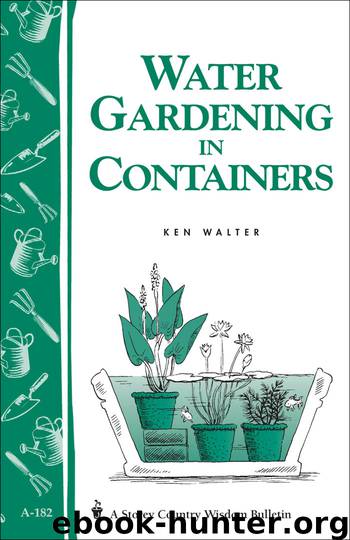Water Gardening in Containers by Ken Walter

Author:Ken Walter
Language: eng
Format: epub
Publisher: Storey Publishing, LLC
Published: 1998-03-25T16:00:00+00:00
A large water garden container with built-in ledges, large and small baskets, bowls, and pots are some options for containers.
Do your actual potting in a shady, windless area. Direct sunlight will stress the bare roots, and the wind will dry the total plant excessively.
Once you’ve selected a pot, regardless of the specimen to be potted you should line that pot with a layer or two of newspaper or burlap, or a single layer of a landscaping material that allows water to penetrate; any of these will keep soil from drifting into the solution. If the pot has a small bottom, I find something small and heavy to place there. An easily tipped pot will cause real troubles in water quality.
A “heavy” garden soil is the best planting medium. Avoid organic matter in any visible form, and under no circumstances should you use a potting soil of any variety (both can foul the water). There is a special ready-made water plant or aquatic medium sold and it has merit, but it’s expensive. Completely chemical-free all-clay kitty litter can also be used as a planting medium. Both of these substitutes for garden soil require frequent additional fertilization of the plants, since neither has the mineral content necessary for plant growth. Their value comes from being available to people with no yard. They certainly are less messy!
If garden soil is to be used, locate as dry a soil as possible, or dry it enough to allow it to be screened before use. If it can’t be screened, pick out the superhard lumps and all rocks. Prepare several quarts of planting medium — even if you have too much, you can tag it and save it for later. Further prepare each batch of soil by stirring in an additive of no less than a tablespoon of dry, low-nitrogen fertilizer per quart of soil. This will encourage root growth and blossoming, and not just foliage, since nitrogen aids lush leaf growth but does not assist flowering. Place an inch or two of the amended medium in the pot and press it firmly.
Carefully separate and extend the plant’s roots as you place it in the pot. Pour the dry or damp soil through your fingers into the pot, filling in around the roots. Maintain the plant crown at the highest pot level. Press the medium firmly. When the pot is full, place it in another container of water, but don’t totally immerse the pot. Allow the water to be absorbed. After removing the pot from the water, press the soil firmly around the plant roots again. Do not hurry this stage. If you do not have firm soil, the plant will not anchor itself firmly enough to grow well. More important, the loose soil will eventually ooze into the water, making it very difficult to maintain clarity. With the pot filled with soil to its top, set it away from wind and sun to drain.
After the pot has drained for several hours, you should be able to press the soil even more firmly into it.
Download
This site does not store any files on its server. We only index and link to content provided by other sites. Please contact the content providers to delete copyright contents if any and email us, we'll remove relevant links or contents immediately.
| Container Gardening | Hydroponics |
| Organic | Propagation & Cultivation |
| Topiary | Urban |
| Water Gardens & Ponds |
Turbulence by E. J. Noyes(7032)
The Thirst by Nesbo Jo(5778)
Gerald's Game by Stephen King(3913)
Be in a Treehouse by Pete Nelson(3206)
Marijuana Grower's Handbook by Ed Rosenthal(3114)
The Sprouting Book by Ann Wigmore(3049)
The Red Files by Lee Winter(2908)
The Remains of the Day by Kazuo Ishiguro(2614)
Sharp Objects: A Novel by Gillian Flynn(2440)
Christian (The Protectors Book 1) by L. Ann Marie(2393)
Organic Mushroom Farming and Mycoremediation by Tradd Cotter(2304)
The Culinary Herbal by Susan Belsinger(2055)
Stone Building by Kevin Gardner(1992)
The Starter Garden Handbook by Alice Mary Alvrez(1922)
Lilac Girls by Martha Hall Kelly(1868)
The Unlikely Pilgrimage of Harold Fry by Rachel Joyce(1834)
The Lean Farm Guide to Growing Vegetables: More In-Depth Lean Techniques for Efficient Organic Production by Ben Hartman(1782)
Urban Farming by Thomas Fox(1748)
Backyard Woodland by Josh VanBrakle(1586)
